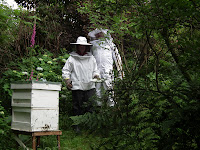It is the middle of the festive season and things are quite different to previous times. We are now further away from the children and because of this, and because they are now adults (some with children of their own), this is the first Christmas I haven't had to be Santa. Although this is a little sad at least I didn't have to have a midnight carrot (for Rudolph) and a glass of tepid milk. A further difference is that work doesn't really stop on the smallholding, the animals don't decide to take a holiday for a fortnight so the daily rhythms continue largely unaltered.
As winter is really here we have started giving the sheep the hay we made this summer. All the hard work over those brief, sunny days seems to have paid off and I am glad to say it seems that the sheep have given the thumbs up to their new fodder. From the first time they saw me walking over with the first bale they have oriented to it. Usually my presence sends them to the other end of the field and it is quite unusual to see them follow me around rather than running away.
Once the hay is in the manger, and I have stepped away to about 2 yards away from the manger, down they come en masse. I misjudged the manufacture of the manger. I had planned for seven sheep standing around it nibbling at the hay. I had not anticipted seven sheep, and about 300kg, pushing and shoving for position and climbing over the manger. Wood was not the best material and I will have to get, or make, a metal one. Hopefully, over the winter, as they get to associate us with food then they may become slightly more domesticated and slightly easier to work with.
The festive weather has been wet, cloudy and cold. This has brought the possibility of a hydro-electric scheme back to mind. Our neighbour has quite advanced plans for his scheme on the same river as runs through our wood. He called round this week with equiptment to survey our land (he had just done his). We have a respectable drop of about 16 meters from the beginning of the leat to the site of the old waterwheel and rough calculations suggest we may be able to generate around 4Kwh. While we were looking at the site of the old Pelton wheel we are quite impressed by the amount of the building and channelling which still remains. It also looks like our pond is less decorative than possibly being a header tank for the water wheel.
We have booked a preliminary visit for a site survey and may make this a project for the new year. It certainly seems a better bet to rely on rain, rather than sun, for energy generation in North Wales. So perhaps next year Sion Corn might have to bring a waterwheel if I am good
Nadolig llawen a blwyddyn newydd dda !
As winter is really here we have started giving the sheep the hay we made this summer. All the hard work over those brief, sunny days seems to have paid off and I am glad to say it seems that the sheep have given the thumbs up to their new fodder. From the first time they saw me walking over with the first bale they have oriented to it. Usually my presence sends them to the other end of the field and it is quite unusual to see them follow me around rather than running away.
The festive weather has been wet, cloudy and cold. This has brought the possibility of a hydro-electric scheme back to mind. Our neighbour has quite advanced plans for his scheme on the same river as runs through our wood. He called round this week with equiptment to survey our land (he had just done his). We have a respectable drop of about 16 meters from the beginning of the leat to the site of the old waterwheel and rough calculations suggest we may be able to generate around 4Kwh. While we were looking at the site of the old Pelton wheel we are quite impressed by the amount of the building and channelling which still remains. It also looks like our pond is less decorative than possibly being a header tank for the water wheel.
We have booked a preliminary visit for a site survey and may make this a project for the new year. It certainly seems a better bet to rely on rain, rather than sun, for energy generation in North Wales. So perhaps next year Sion Corn might have to bring a waterwheel if I am good
Nadolig llawen a blwyddyn newydd dda !







































































